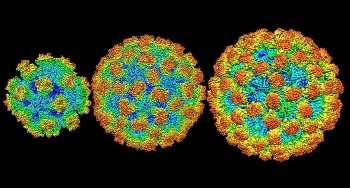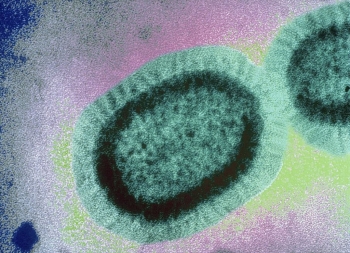What is Chlamydia: Infections, Symptoms and Treatment
What is chlamydia?
 |
Chlamydia trachomatis bacteria. Photo: Health |
Chlamydia is a common infection spread by sexual contact. While easily treated with antibiotics, many of the nearly three million women and men infected each year do not seek treatment—probably because they don’t realize they have it. And that can lead to complications, including difficulty getting pregnant or carrying a pregnancy to term.
Chlamydia definition
Chlamydia is a sexually transmitted disease (STD) caused by Chlamydia trachomatis bacteria. You can get it by having vaginal, anal, or oral sex with someone who has the infection. Chlamydia bacterial infections are more common among sexually active teens and young adults.
Chlamydia may cause vaginal or penile discharge or a burning sensation during urination, among other symptoms. It can take time—usually one to three weeks—for symptoms to appear after having unprotected sex with someone who has the infection. Still, some people don’t notice symptoms at all.
Untreated chlamydia can cause permanent damage to a woman’s reproductive system, leading to fertility problems and preterm birth. Because of this risk, sexually active women younger than 25 should get tested annually for chlamydia, even if they do not have symptoms. Testing is also recommended for women of any age who have an increased risk of chlamydia, like those with multiple sex partners, a new sex partner, or a partner with another STD. A simple urine test can tell you whether you have chlamydia. If you test positive, you and your sex partner should be treated with antibiotics.
Types of Chlamydial Infections
According to Health, there are two other types of chlamydial infections in addition to standard genital infections, though these are less common in the United States.
Lymphogranuloma Venereum: Chlamydia also causes a sexually transmitted infection called lymphogranuloma venereum, which has symptoms much different than standard genital chlamydia infections. It has historically been thought of as a condition found in third-world countries, but its incidence is increasing worldwide, including in the United States. It is more common in MSM, and the symptoms are similar to syphilis. It is caused by chlamydia serovars (types) L1, L2, and L3.
Trachoma: Trachoma is an eye infection caused by the chlamydia bacteria known as serovars A through C. Unlike genital infections and lymphogranuloma venereum, trachoma is not considered to be an STI. While it is uncommon in the United States, it is the leading infectious cause of blindness worldwide. It is caused by autoinoculation (when people touch a surface containing the bacteria and then touch their eyes) and can be spread by hands, clothing, bedding, or even flies.
Signs and symptoms of chlamydia in women
Chlamydia infects the cervix (the passageway connecting the vagina and uterus). Women often have no obvious signs of illness, especially soon after being infected. When symptoms do occur, common signs include a burning pain with urination, pain with intercourse, or an abnormal, smelly vaginal discharge.
Chlamydia can also cause rectal pain, discharge, or bleeding.
It’s possible for infected body fluids to enter a sex partner’s eye, causing the clear membrane to protect the outer layer of the eye to become inflamed. Chlamydia can infect the throat after unprotected oral sex, but it’s less common and usually doesn’t cause symptoms.
Since many women have no noticeable symptoms at all, they don’t seek treatment, and that can set the stage for serious health problems.
Untreated cases of chlamydia make women more susceptible to other STDs, including HIV. Chlamydia can also lead to a more serious condition called pelvic inflammatory disease (PID). PID infects the reproductive organs. It can lead to an ectopic (tubal) pregnancy or miscarriage. Women with PID may struggle with infertility. The condition can also cause long-term pelvic pain.
Chlamydia symptoms in women may include:
- Pain or burning while urinating
- Abnormal, smelly vaginal discharge
- Painful sex
- Bleeding after sex
- Frequent urge to urinate
- Rectal pain or discharge
- Bleeding between periods or heavier periods
- Lower abdominal pain, nausea, or fever
- Eye redness, pain, swelling, irritation, or discharge
Signs and symptoms of chlamydia in men
 |
| Chlamydia prevention. Photo: Health |
Men get chlamydia too, and like women, they often don’t have symptoms. Chlamydia can infect the urethra, the tube that connects the bladder to the penis and allows urine to pass. Symptoms, if they surface, usually appear one to three weeks after a man is exposed to the infection. Chlamydia can cause a burning sensation during urination. Men may notice a clear or cloudy discharge from the tip of the penis.
In men, as in women, chlamydia can infect the anus, possibly leading to rectal pain or discharge. When bacteria-containing secretions enter the eyes, this STD can lead to eye pain and other symptoms. Less often, chlamydia can cause a throat infection, but there may not be any evidence of chlamydia in the mouth because it usually doesn’t cause symptoms.
Chlamydia symptoms in men include:
- Penile discharge
- Burning pain during urination
- Frequent urge to urinate
- Pain in one or both testicles
- Rectal pain, discharge, or bleeding
- Eye redness, pain, swelling, irritation, or discharge
Chlamydia treatment
According to Health, Chlamydia is treated with prescription antibiotics;1 there are currently no effective over-the-counter or home remedies. There are recommended treatments and alternative options for both adults and pregnant women. When a person is diagnosed with chlamydia, all sexual partners they have had within the last 60 days must also be screened and treated. You must take all of the medication prescribed to you to eradicate the bacteria, and prescriptions should not be shared. It is recommended that people abstain from sex for seven days after treatment has begun.
 | Top 15 most common infectious diseases in the United States (part 2) People in the United States continue to get diseases that are vaccine-preventable. The list below aims to provide basic information about the top 15 most ... |
 | Top 15 most common infectious diseases in the United States (part 1) People in the United States continue to get diseases that are vaccine-preventable. The list below aims to provide basic information about the top 15 most ... |























